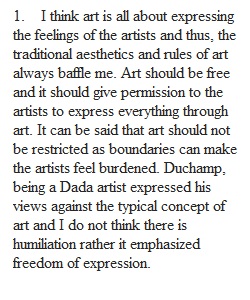


Q To prepare for this assignment, view the YouTube video Marcel Duchamp: The Radical Artist Who Changed the Course of Art (5:41). This brief video will provide you with an introduction to Duchamp, his life, his art, and his legacy. After watching that video, read the textbook section on Duchamp and his legacy (pp. 371-2) and answer this first question. (NOTE: there are more questions to come!) 1. What do you think about L.H.O.O.Q.? Is it funny? Disrespectful? Or what? What do you think was Duchamp’s purpose in "creating" this work? The textbook mentions that Duchamp accented both the masculine and the feminine in L.H.O.O.Q. The video you watched mentioned his use of a feminine alter-ego as well. In the next video, Marcel Duchamp, The Large Glass (7:27), you will learn about one of Duchamp's masterpieces, originally titled The Bride Stripped Bare By Her Bachelors, Even. Because the title is so long and awkward, it's usually called "The Large Glass." Watch the video and learn about this amazing and challenging work of art. Then answer these next numbered ( 2, 3, 4, 5) discussion questions: 2. Do you think Duchamp made a valid point by emphasizing machines and other man-made objects in this work of art? How did that relate to world events taking place at that time? 3. What do you think artists in the 21st century should be emphasizing if they want to implicate world events and modern technology? 4. The commentators talk about chance and being unintentional in creating some aspects of this work, especially the "bullet holes" drilled into the glass. Duchamp himself didn't consider the work finished until the glass broke, which was not his original intention. Some famous artists that we've looked at previously, like Jackson Pollock, relied on chance in their work. What do you think about the use of chance in art? Does a reliance on chance and a lack of intentionality lower the artistry? Or is relying on chance a valid art technique? Why or why not? 5. Comment on Duchamp's "signature" and how it relates to his interest in masculine vs. feminine qualities in this piece. NOTE: There are FIVE questions to be answered in this journal - one about LHOOQ and four regarding The Large Glass. Use your brain to answer these questions, but you don't need to write "long" essays. The goal of this journal is to do what Duchamp wanted to do: make you THINK. Remember, your participation and response should clearly reflect your reading, critical thinking, and understanding of the chapter and specific content for this session.
View Related Questions